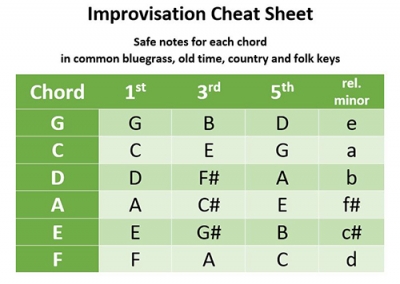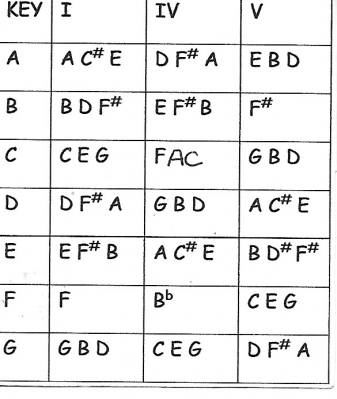Welcome to our forum. A Message To Our New and Prospective Members . Check out our Forum Rules. Lets keep this forum an enjoyable place to visit.
Currently working on errors from the latest (SimplePress) forum update. Many issues have been resoled and others are being worked on. Thank you for your patience.
 Topic RSS
Topic RSS



 (0 votes)
(0 votes) Regulars
 Offline
Offline

@KindaScratchy Great minds think alike!! I have a similar cheat sheet for my jams for the chords. I was placing it on my leg but it kept sliding off. I started putting it on the ground and at every jam someone asks to pick it up!!
This last Tuesday I didn't use the chart. I used chunking on the songs with the keys I didn't know or am not used to - B, E, F.
I am a bit confused as to when to use III or IV. I think at my jam it is usually IV but on occasion I bet there is a III thrown in. I have not learned those chords yet.
What would the chords be for the key of F and V for the key of B?
Is this chart correct?
At jam my eyes are glued on the hands of the guitar players!! Check out the guitar
Violinist start date - May 2013
Fiddler start date - May 2014
FIDDLE- Gift from a dear friend. A 1930-40 german copy, of a french copy of a Stradivarius. BOW - $50 carbon fiber. Strings - Dominants with E Pirastro Gold string.
Members
 Offline
Offline





Well the notes to the F I chord (F major) are F, A, C.
The notes for the IV chord for that key (the Bb) are Bb, D, F
The notes to the V chord for the key of B (the F# Major chord) are F#, A# and C#
In most of the progressions you're likely to encounter, the III chord would be a iii chord, meaning it would be the minor chord. And as long as we're on that topic, another you will see fairly often is the vi chord, which is the relative minor chord mentioned in KindaScratchy's chart.
Good cheat sheets, folks! Nice bit of applied theory.
One other thing I will mention is that improvising out of the chord notes for ach chord as they change will tend to "lean" your improvisation a bit towards the accompaniment. If you wanted to "lean" more towards the main melody, that will usually be in a scale or mode that doesn't usually change unless the key of the song actually changes, a "modulation". But KindaScratchy is quite correct in that you won't be playing any "off" notes if you are improvising from the notes of the chords and changing the notes you use to follow each chord change. Either way can work, and which you use depends on what you like.
"This young wine may have a lot of tannins now, but in 5 or 10 years it is going to be spectacular, despite the fact that right now it tastes like crude oil. You know this is how it is supposed to taste at this stage of development." ~ Itzhak Perlman
Regulars
 Offline
Offline

Thanks!! Where I seemed to get confused is switching from thinking about keys to chords and visa versa. I'm not sure why.
If I recite and count the notes out on my fingers for the different chords I understand .... until I blink!!!
Violinist start date - May 2013
Fiddler start date - May 2014
FIDDLE- Gift from a dear friend. A 1930-40 german copy, of a french copy of a Stradivarius. BOW - $50 carbon fiber. Strings - Dominants with E Pirastro Gold string.
Regulars
 Offline
Offline

Hey @KindaScratchy Yep, different fingerings for some of the chords - I have run into that. I have also noticed that even the very same fingering of a chord can look different on a different guitarist's hand. I think it might dependent on the difference of the actual hand - stiff knuckles, chubby fingers, using the thumb to play the top string, etc.
Thanks for explaining that - relative minor column.
Violinist start date - May 2013
Fiddler start date - May 2014
FIDDLE- Gift from a dear friend. A 1930-40 german copy, of a french copy of a Stradivarius. BOW - $50 carbon fiber. Strings - Dominants with E Pirastro Gold string.
Members
 Offline
Offline





Good looking chart! I'd say laminate a copy and keep it tucked in your case.

I do have one question though.. Do fiddlers or bluegrass players use a different variation of the Nashville Number System? The version I've seen (some years ago, at least) used "Arabic" numerals instead of "Roman" and a minus sign "-" to show minor, so instead of I IV V vi, it looked like 1 4 5 6-.
I always thought the break from Roman numerals was kind of sensible, since we usually would say the "five" or the "four" instead of the "Vee" or "Eye-Vee", and on a cramped and hastily scribbled chart, it can be hard sometimes to tell if someone meant you are supposed to play the IV chord, or a I chord and then a V chord.
Nashville Number System wasn't covered when I took music, but I met a couple players over the years who used it. Some of it, like the dots over the numbers on a song chart to tell what beats to play on, I never quite "got", but most of it seemed easy enough to figure out. I never had a teacher who used it or was in a band that used it, so I never actually learned the details or nuances of it. And I also might be confusing it with some other system, perhaps.
Your table though, at least appears to be done in the "traditional" (18th century) theory notation, with Roman numerals and "m" to indicate a minor chord? So I'm wondering if maybe there is a different NNS or a hybrid that is used sometimes?

In any case, though.. It's a nice little table, easy to read and a lot of info packed into a small space. Kudos, KindaScratchy!
"This young wine may have a lot of tannins now, but in 5 or 10 years it is going to be spectacular, despite the fact that right now it tastes like crude oil. You know this is how it is supposed to taste at this stage of development." ~ Itzhak Perlman
Regulars
 Offline
Offline

@KindaScratchy Cool!! I am definitely printing that off!!
@DanielB At jam camp we were taught to use Arabic numbers. When I showed one of the guitar players at the weekly jam I attend numbers instead of the notes he didn't know what they meant!!
Violinist start date - May 2013
Fiddler start date - May 2014
FIDDLE- Gift from a dear friend. A 1930-40 german copy, of a french copy of a Stradivarius. BOW - $50 carbon fiber. Strings - Dominants with E Pirastro Gold string.
Regulars
 Offline
Offline

This is what I showed him.
http://www.musicpotential.com/.....chor333952
ElK Rivers Blues is a great tune!!
Violinist start date - May 2013
Fiddler start date - May 2014
FIDDLE- Gift from a dear friend. A 1930-40 german copy, of a french copy of a Stradivarius. BOW - $50 carbon fiber. Strings - Dominants with E Pirastro Gold string.
Members
 Offline
Offline





I had to blink and think for a second the first time I saw a 37 chord when going down that list..

I got it, though..LOL
Q. What do you call a guitarist that only knows 2 chords?
A. A critic.
Q. How many guitarists does it take to change a lightbulb?
A. One to change it and 6 to stand around talking about how they could have done it better.
or
A. "Omigosh! You CHANGED the original bulb in a VINTAGE 1967 Sears and Roebuck table lamp? That was a CLASSIC! Oh crap, you know you totally ruined the investment value, don't you? And it will just never sound the same again, now."

"This young wine may have a lot of tannins now, but in 5 or 10 years it is going to be spectacular, despite the fact that right now it tastes like crude oil. You know this is how it is supposed to taste at this stage of development." ~ Itzhak Perlman








Members
 Offline
Offline





Thanks for the clear-up, Diane!
Yeah, I've only run into players using it a few times over the year. Maybe it's more common in other parts of the country or other genres. By the time I'd heard of NNS, I was already familiar with the same sort of principles from music theory classes, so I never looked into it much.
"This young wine may have a lot of tannins now, but in 5 or 10 years it is going to be spectacular, despite the fact that right now it tastes like crude oil. You know this is how it is supposed to taste at this stage of development." ~ Itzhak Perlman
1 Guest(s)


 Log In
Log In Register
Register















